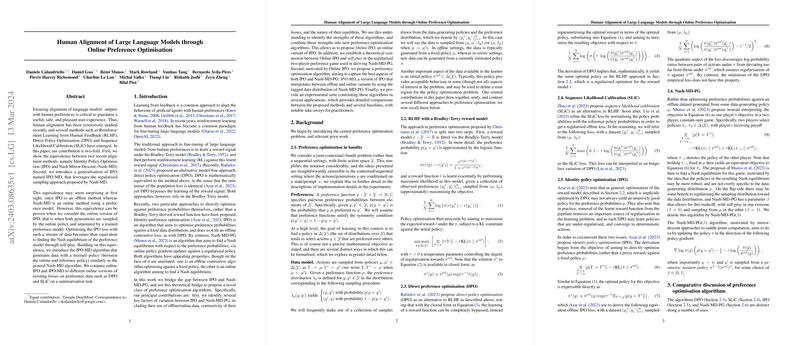Human Alignment of LLMs through Online Preference Optimization
Overview of the Paper
This paper contributes significantly to the field of human alignment in LLMs, focusing on the mechanism of online preference optimization. It provides a novel perspective on aligning LLMs with human preferences, leveraging the regularized sampling approach. The authors initially establish the equivalency between two prominent alignment methods: Identity Policy Optimization (IPO) and Nash Mirror Descent (Nash-MD), underpinning their analysis with theoretical insights that unravel this unexpected connection. Subsequently, they introduce a generalization of IPO, named IPO-MD, which amalgamates the strengths of both initial methods, shedding light on potential pathways for refining preference optimization in LLMs.
Theoretical Insights
The equivalence between IPO and Nash-MD is a surprising reassessment of our understanding of alignment methods in LLMs. Traditionally viewed through separate lenses—offline for IPO and online with a preference model for Nash-MD—their equivalence is proven under the conditions of an online variant of IPO. This variant relies on online policy sampling and a human-trained preference model, establishing a connection with the Nash equilibrium of the preference model through self-play optimization. This theoretical underpinning pivots the discourse towards viewing these approaches as complementary rather than disparate, with each possessing unique advantages in the context of human alignment.
IPO-MD Algorithm
Building on the theoretical equivalence, the authors propose the IPO-MD algorithm, a blend of online IPO and the Nash-MD framework. IPO-MD targets the best aspects of both: it is a contrastive algorithm leveraging online data sampling with a mixture policy that combines the online policy dynamics with those of a reference policy. This hybrid approach aims to strike a balance between learning efficiency and the flexibility of adjusting to varying data distributions, promising to enhance the alignment process.
Experimental Insights
The paper presents an in-depth experimental analysis, comparing online IPO and IPO-MD against other prevailing methods like DPO and SLiC, particularly focusing on a summarization task. The results underpin the robustness of IPO-MD in aligning LLM outputs with human preferences, delineating its competency in navigating the complex landscape of preference optimization. These experiments act as a testament to the practical viability of the theoretically motivated IPO-MD algorithm, offering a promising outlook for future developments in LLM alignment.
Implications and Future Directions
The theoretical analysis and empirical results presented in this paper underscore the potential of combining offline and online optimization strategies for aligning LLMs with human preferences more effectively. The findings suggest that hybrid approaches, exemplified by IPO-MD, could offer more nuanced control over the alignment process, potentially mitigating issues related to reward hacking and overoptimization. This research opens up new avenues for exploring advanced preference optimization methods, suggesting a future where LLMs can be more reliably and efficiently aligned with human values and expectations.
As the field of generative AI and LLMs continues to evolve, the insights from this paper may guide the development of more sophisticated and human-aligned models. Further research could expand the applicability of these findings across diverse tasks and settings, enhancing our understanding of the intricate relationship between LLM behavior and human preferences.
